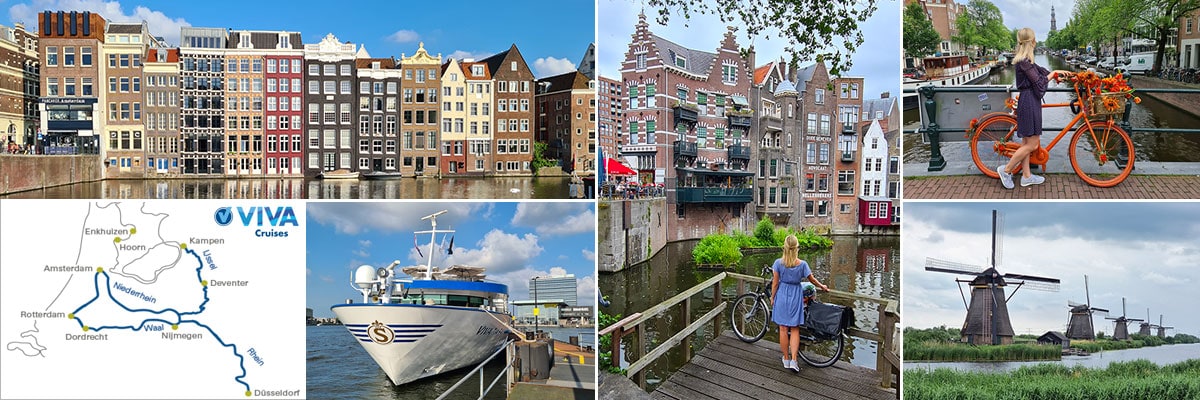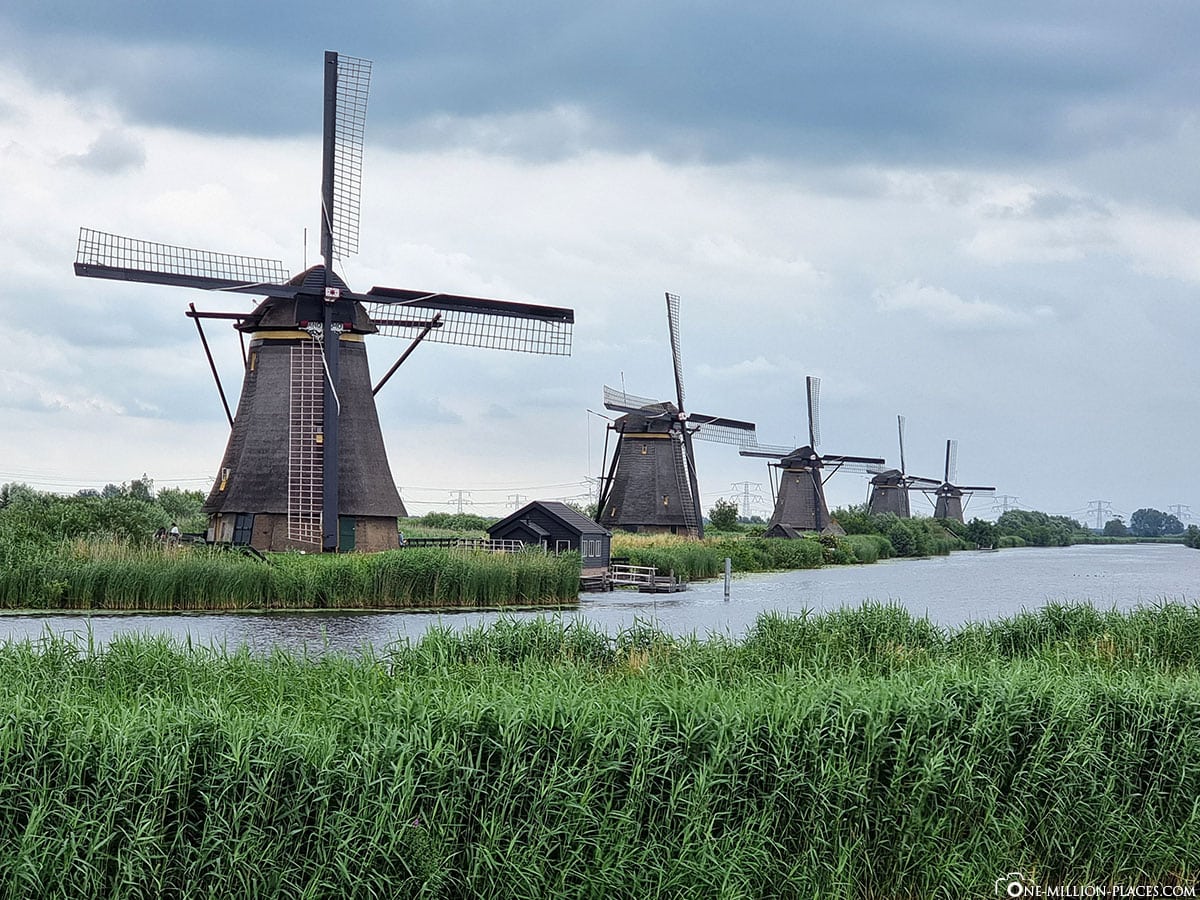In the Netherlands, there are 10 UNESCO-recognized World Heritage Sites, such as the canals of Amsterdam, the Schokland, the Wadden Sea in the North Sea or the Wouda Pumping Station. We wanted to visit another World Heritage Site today: the historic windmills of Kinderdijk.

Table of contents
Things to know about the windmills of Kinderdijk
About 15 km southeast of Rotterdam are the 19 historic windmills of Kinderdijk, which are among the most famous sights in the Netherlands. They were built in the 18th century and served to pump out the water from dywn areas in order to make the soil agriculturally usable. To do this, the mills first pump the water into the Nieuwen Waterschap Canal, from where it finally flows into the Lek River. Due to the sophisticated system of windmills and pumping stations that has kept the soil in the region dry for centuries, the area and windmills were added to the list of UNESCO World Heritage Sites in 1997.
However, the history of Kinderdijk begins much earlier, because the first settlers had to struggle with the water about 1,000 years ago. Dikes were built and attempts were made to divert the ground and rainwater from the soils within the into the river behind them in order to protect the areas from renewed flooding. These old canal systems had proved to be ineffective over time and so an idea had to be found to keep the water away: the WIndmühlen of Kinderdijk.
By the way, what we found quite interesting: Much of the mills are still inhabited and privately owned. Therefore, you can not visit all of them, but only three museum windmills. Almost all mills are inhabited by at least one person who is in possession of a miller’s diploma. This means that they are authorised to use these machines for the actual grinding. But since you can no longer earn much money with it, most still have a “normal” job: some are carpenters, others bank employees or teachers.
By Waterbus from Dordrecht to Kinderdijk
From our VIVA pier in Dordrecht it was very easy to get to Kinderdijk by public Waterbus. The stop for the Waterbus is located in Dordrecht an der Merwekade. From here you take the ferry towards Rotterdam and after about 25 minutes drive at the stop “Ridderkerk, De Schans” change to the ferry to Kinderdijk, which leaves at the end of the jetty. From here it is another 10 minutes drive to the stop “Kinderdijk, Molenkade”. The one-way trip with the Waterbus cost us 4.40 EUR per person, the ferry to Kinderdijk another 2 EUR. Tickets can be purchased directly on the ferries.
The visitor center, opening hours & entrance fees
An interesting and important piece of information is that the area where the windmills of Kinderdijk are located is completely freely accessible at all times and you do not have to pay anything for it. This is because a public (car-free) road runs through the site. However, if you want to visit three of the windmills from the inside, use the Canal Hopper to the museum mills Overwaard and Blokweer and take a boat trip with the Canal Cruiser along the mills, an entrance fee is due. This is 16 EUR per person on weekdays and 18.50 EUR per person on weekends. Tickets can either be purchased online in advance or at the visitor centre, which is located directly at the entrance. As a rule, the museum area is open in summer from 9.30 a.m. to 5.30 p.m., in low season the opening hours are more limited.
The path along the windmills
If you enter the area from the visitor center and walk or cycle along the path, you will see that the waterways divide the mills of Kinderdijk into three different types:
(1) On the right are eight Nederwaard mills from 1738, built of red bricks.
(2) On the left side there are eight octagonal, wooden Overwaard mills directly on the waterway as well as two similar mills a little further inside. Most of these mills were built in 1740, one a little later in 1761.
(3) If you continue along the path, you will discover a Blokweer mill made of dark wood on the right side at the end. The mill from 1630 fell victim to several fires, most recently in 1997. It was then rebuilt and restored.
From the way you always have a beautiful view of the various windmills, which are simply great photo opportunities – especially when they are reflected so beautifully in the water.
The old Pumping Station
The ticket price also includes a visit to the old steam-powered pumping station from 1868, which was retrofitted with electric pumps in 1924. Nowadays, the pumping station no longer plays a role in Kinderdijk’s water management. In the old pumping station there is now a very interesting museum of history.
The museum windmill “Nederwaard”
In total, there are three museum windmills on the grounds of Kinderdijk. The museum windmill Nederwaard is the 2nd windmill on the right hand after the visitor centre. In front of the site of this mill there is a ticket control, so really only those people who have bought a ticket in the visitor center get admission. It is worth taking a look at the Nederwaard Mill, built in 1738, to see how people used to live and work here in such a small space – sometimes with a dozen children. The mill is still functional and has been preserved in its original state.
The museum windmill “Blokweer”
The second museum windmill we visited is the Blokweer Mill, built around 1630. The mill was rebuilt and restored after a fire in 2001 and is the only mill in Kinderdijk where the paddle wheel is located outside the mill and is thus visible from the outside. Here, too, we took a look inside and discovered what life was like in the 1950s. We particularly liked the associated mill property, because here is a small vegetable garden, several fruit trees and two goats named Milly and Molly.
A boat ride along the windmills
At the end of our visit to Kinderdijk we took a 30-minute boat ride along the windmills. This ride is included in the entrance ticket and starts at the pier next to the visitor center. With the boat we drove along the canal and were able to take a closer look at the windmills and also take great pictures.
More impressions of the Windmill Park Kinderdijk
We spent about four hours on the site, walked a lot, visited the museum windmills and took countless photos. Unfortunately, it rained heavily in the end, so we had to shelter in the museum shop.
Our tip: If it is enough for you to see the mills only from the outside, you do not have to buy an entrance ticket, but simply stroll along the main path or cycle around by bike and enjoy the landscape and the great atmosphere 🙂
All travel reports of our river cruise on the Rhine
For one week we were on the Rhine with VIVA TIARA from Düsseldorf and got to know some of the most beautiful places in the Netherlands. From the pretty harbor towns of Deventer and Kampen, we continued to Enkhuizen and Hoorn, where we crossed the largest lake in the Netherlands - the Ijsselmeer. From here, our ship took us to the two metropolises of Amsterdam and Rotterdam, on to Dordrecht and the world-famous windmills of Kinderdijk, and finally to the city of Nijmegen. » VIVA Cruises - Our cruise ship VIVA TIARA
» VIVA Cruises - Our cruise ship VIVA TIARA» Deventer - Sights & Photo Spots of the Hanseatic City
» Kampen - Things to do in the former Hanseatic City
» Enkhuizen - Historic harbor town on the IJsselmeer
» Hoorn - Things to do in the historic town
» Amsterdam - The most beautiful photo spots & sights
» Rotterdam - The most beautiful sights & photo spots
» Dordrecht - Sights & our walking tour in the city
» Kinderdijk - The 19 windmills of Kinderdijk in Holland (UNESCO)
» Nijmegen - Sights of the oldest city in the Netherlands
» Düsseldorf - Sights & the most beautiful photo spots

